Abstract
Previous work has shown that the activity of the melatonin-forming enzyme in the rat pineal gland is elevated in rats kept in continuous darkness as compared to those kept in continuous light. Information about environmental lighting reaches the pineal gland via nerves that liberate noradrenaline. Rat pineal glands in organ culture can form C14-melatonin from C14-tryptophan as follows: tryptophan → 5-hydroxytryptophan → serotonin → melatonin.
Noradrenaline was found to stimulate the synthesis of C14-melatonin from C14-tryptophan in rat pineals in organ culture. Other compounds related in structure to noradrenaline increase melatonin and serotonin synthesis and inhibit the formation of the deaminated product of serotonin, 5-hydroxyindole acetic acid. Cycloheximide, a compound that inhibits protein synthesis, also prevents the formation of serotonin, melatonin, and 5-hydroxyindole acetic acid from tryptophan in pineal organ culture. These observations suggest that noradrenaline liberated from sympathetic nerves stimulates the formation of melatonin either by increasing the formation of new melatonin-forming enzyme, by increasing transport of tryptophan into the pineal cell, or by inhibiting the metabolism of serotonin by the alternate deaminating pathway.
Full text
PDF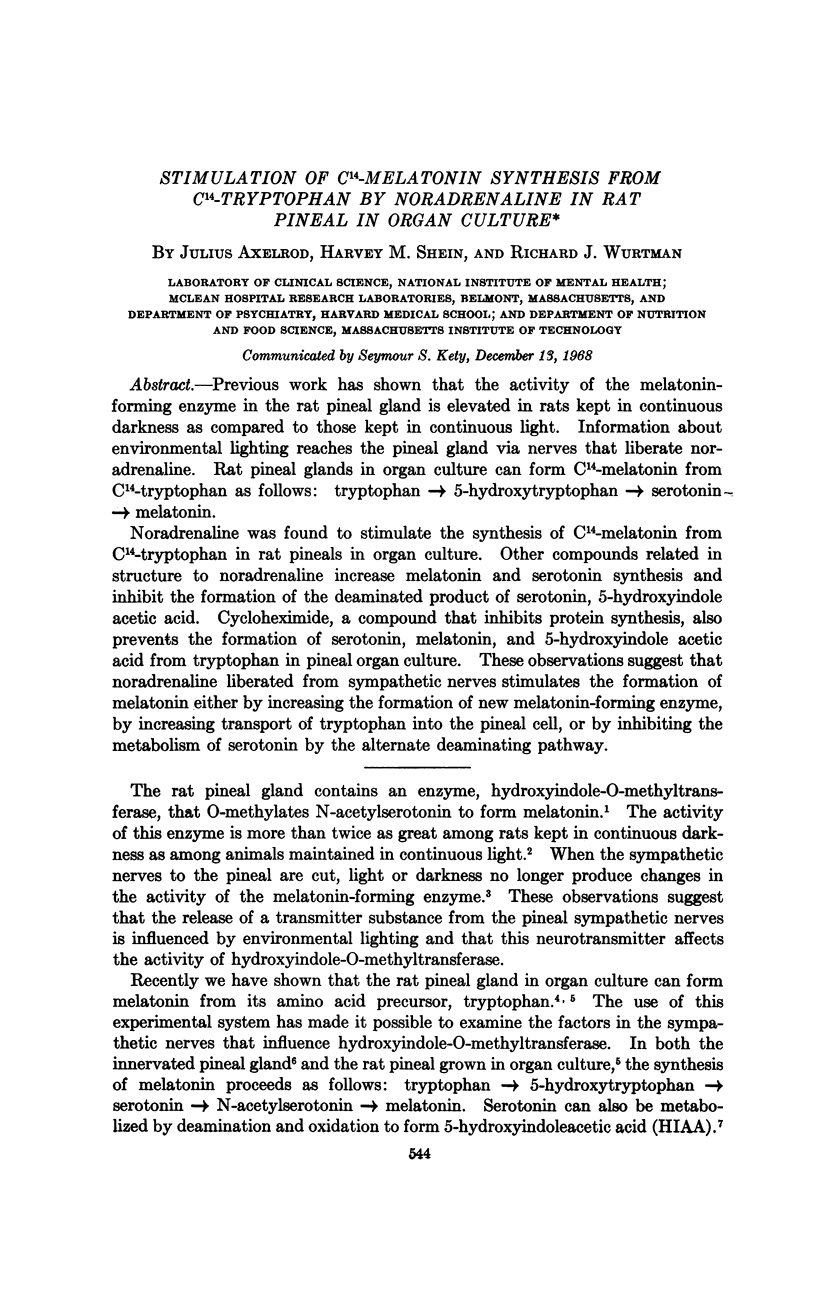

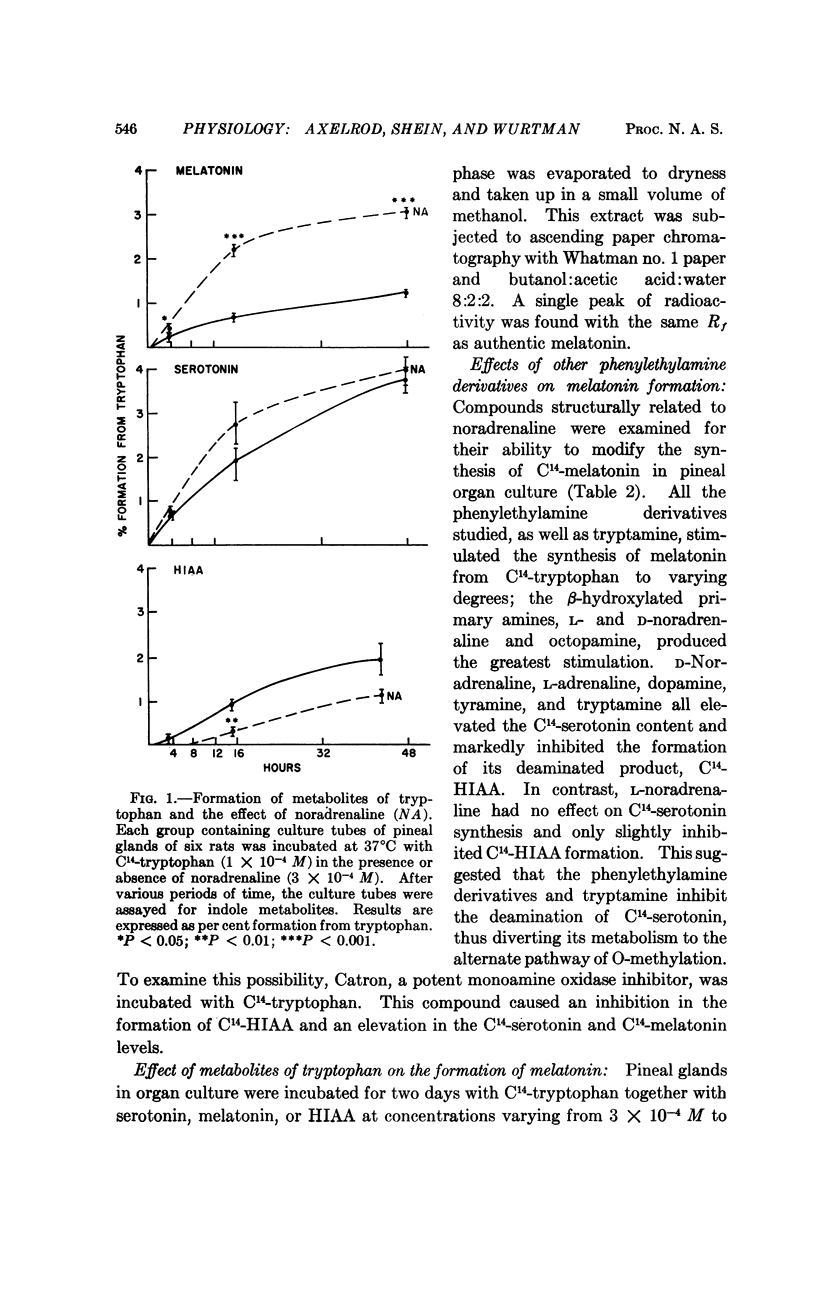
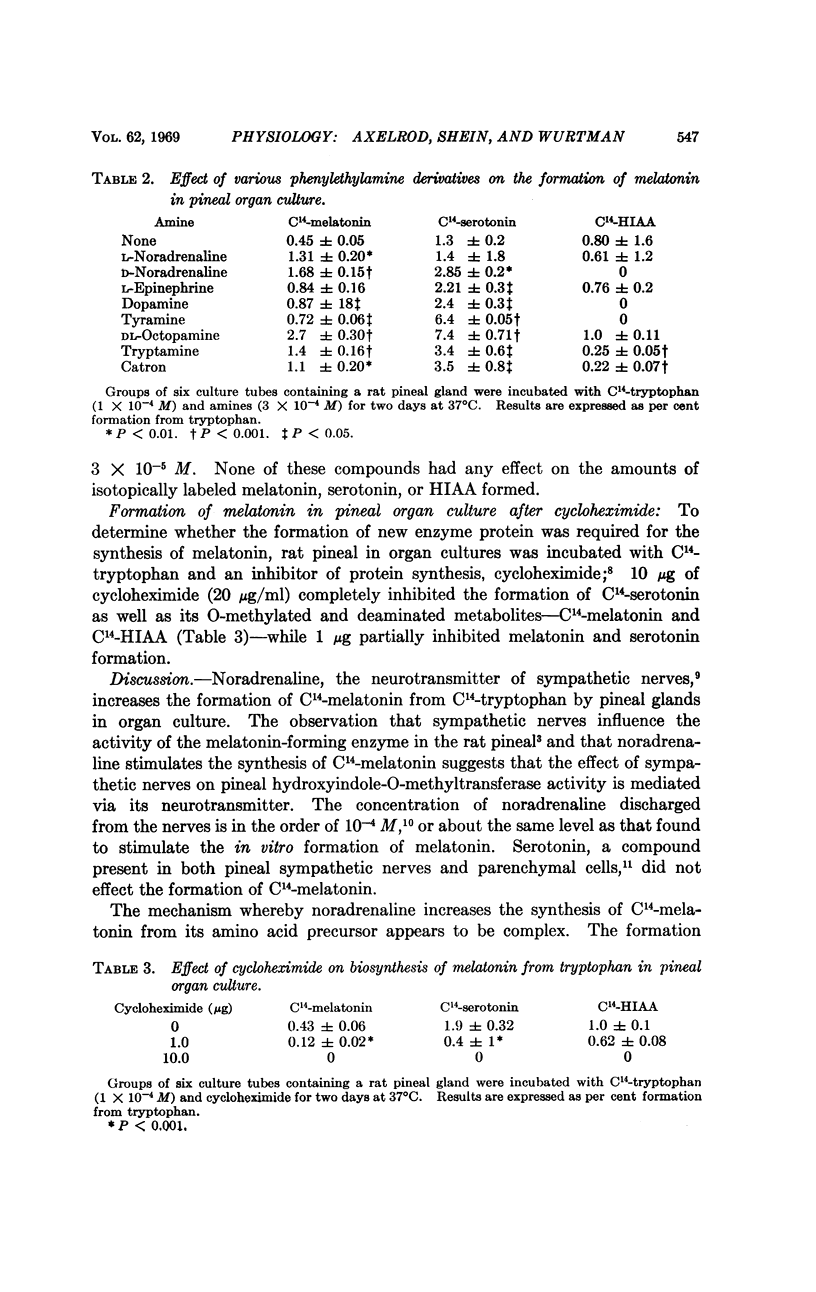
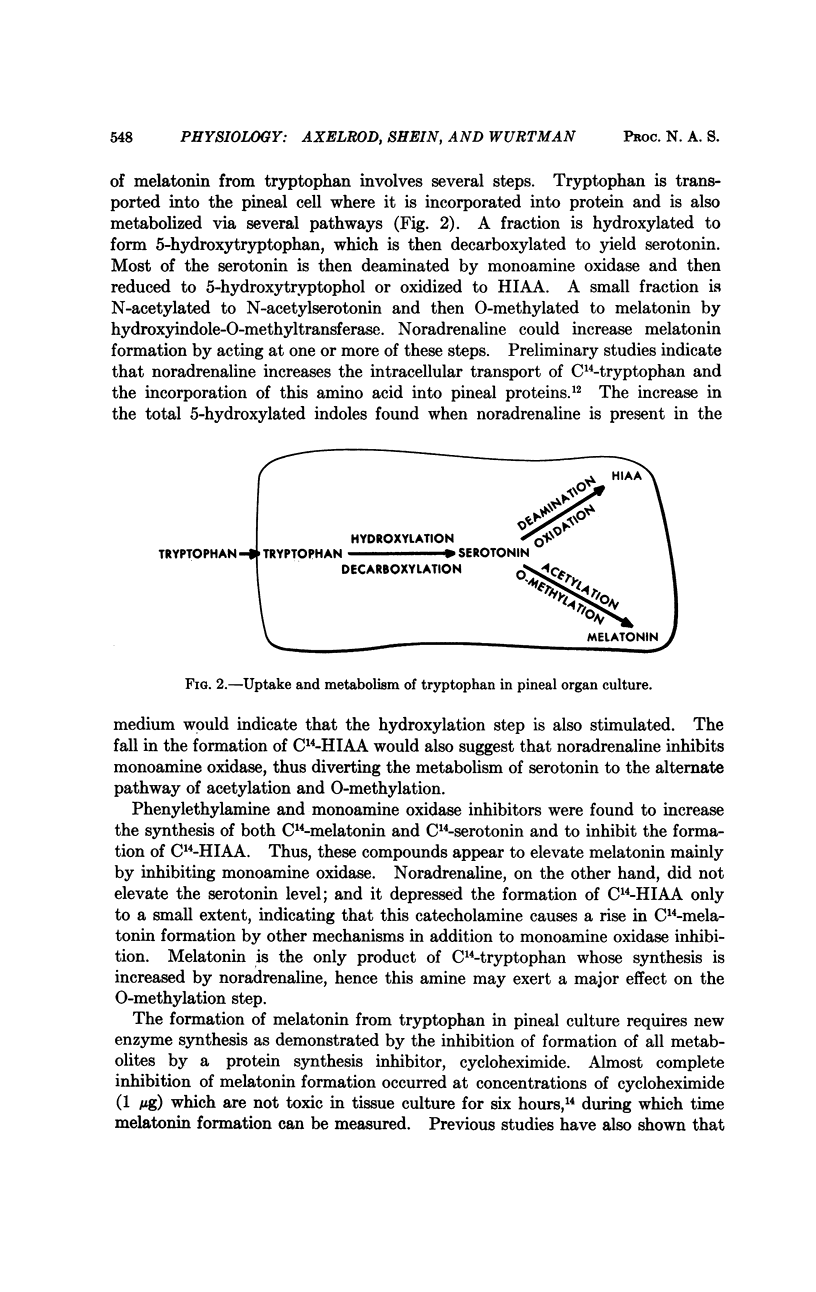
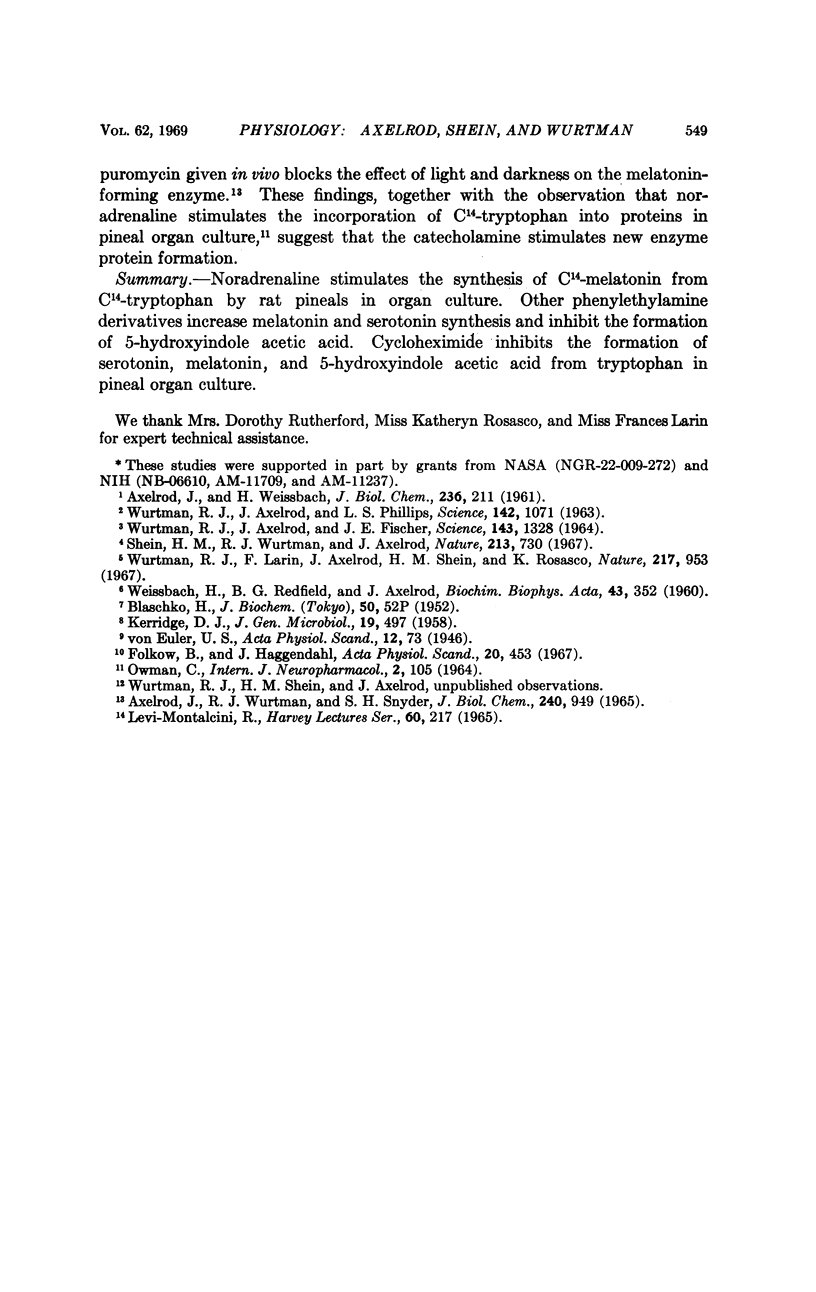
Selected References
These references are in PubMed. This may not be the complete list of references from this article.
- AXELROD J., WEISSBACH H. Purification and properties of hydroxyindole-O-methyl transferase. J Biol Chem. 1961 Jan;236:211–213. [PubMed] [Google Scholar]
- AXELROD J., WURTMAN R. J., SNYDER S. H. CONTROL OF HYDROXYINDOLE O-METHYLTRANSFERASE ACTIVITY IN THE RAT PINEAL GLAND BY ENVIRONMENTAL LIGHTING. J Biol Chem. 1965 Feb;240:949–954. [PubMed] [Google Scholar]
- Folkow B., Häggendal J. Quantitative studies on the transmitter release at adrenergic nerve endings. Acta Physiol Scand. 1967 Jul-Aug;70(3):453–454. doi: 10.1111/j.1748-1716.1967.tb03644.x. [DOI] [PubMed] [Google Scholar]
- KERRIDGE D. The effect of actidione and other antifungal agents on nucleic acid and protein synthesis in Saccharomyces carlsbergensis. J Gen Microbiol. 1958 Dec;19(3):497–506. doi: 10.1099/00221287-19-3-497. [DOI] [PubMed] [Google Scholar]
- Levi-Montalcini R. The nerve growth factor: its mode of action on sensory and sympathetic nerve cells. Harvey Lect. 1966;60:217–259. [PubMed] [Google Scholar]
- OWMAN C. SYMPATHETIC NERVES PROBABLY STORING TWO TYPES OF MONOAMINES IN THE RAT PINEAL GLAND. Int J Neuropharmacol. 1964 Apr;3:105–112. doi: 10.1016/0028-3908(64)90052-8. [DOI] [PubMed] [Google Scholar]
- Shein H. M., Wurtman R. J., Axelrod J. Synthesis of serotonin by pineal glands of the rat in organ culture. Nature. 1967 Feb 18;213(5077):730–731. doi: 10.1038/213730a0. [DOI] [PubMed] [Google Scholar]
- WEISSBACH H., REDFIELD B. G., AXELROD J. Biosynthesis of melatonin: enzymic conversion of serotonin to N-acetylserotonin. Biochim Biophys Acta. 1960 Sep 23;43:352–353. doi: 10.1016/0006-3002(60)90453-4. [DOI] [PubMed] [Google Scholar]
- WURTMAN R. J., AXELROD J., FISCHER J. E. MELATONIN SYNTHESIS IN THE PINEAL GLAND: EFFECT OF LIGHT MEDIATED BY THE SYMPATHETIC NERVOUS SYSTEM. Science. 1964 Mar 20;143(3612):1328–1330. [PubMed] [Google Scholar]
- WURTMAN R. J., AXELROD J., PHILLIPS L. S. MELATONIN SYNTHESIS IN THE PINEAL GLAND: CONTROL BY LIGHT. Science. 1963 Nov 22;142(3595):1071–1073. doi: 10.1126/science.142.3595.1071. [DOI] [PubMed] [Google Scholar]
- Wurtman R. J., Larin F., Axelrod J., Shein H. M., Rosasco K. Formation of melatonin and 5-hydroxyindole acetic acid from 14C-tryptophan by rat pineal glands in organ culture. Nature. 1968 Mar 9;217(5132):953–954. doi: 10.1038/217953a0. [DOI] [PubMed] [Google Scholar]


